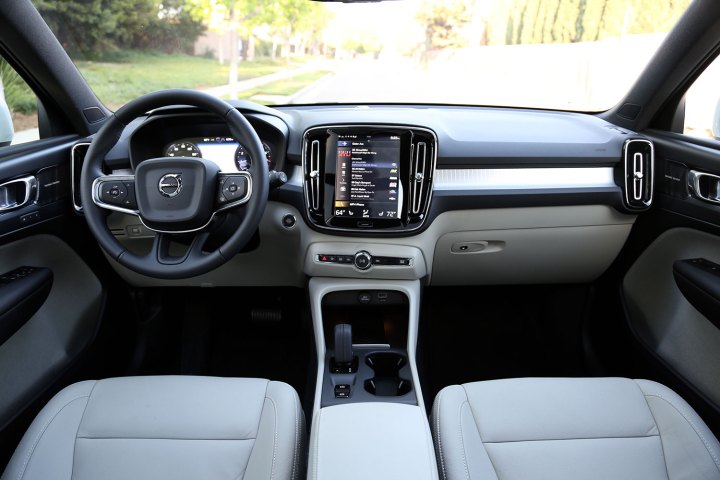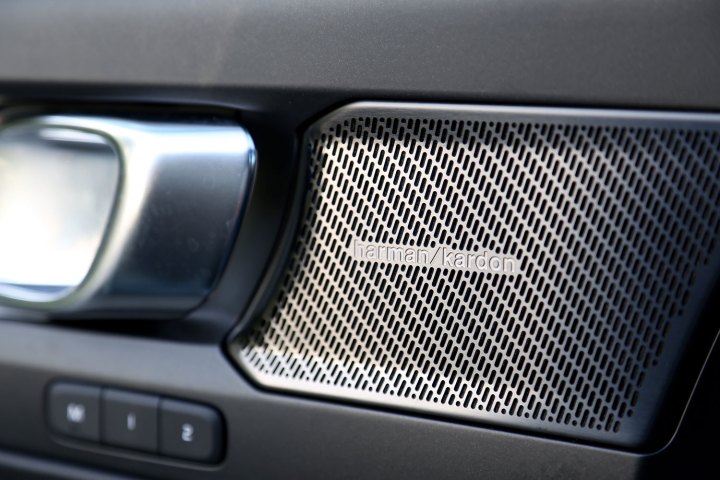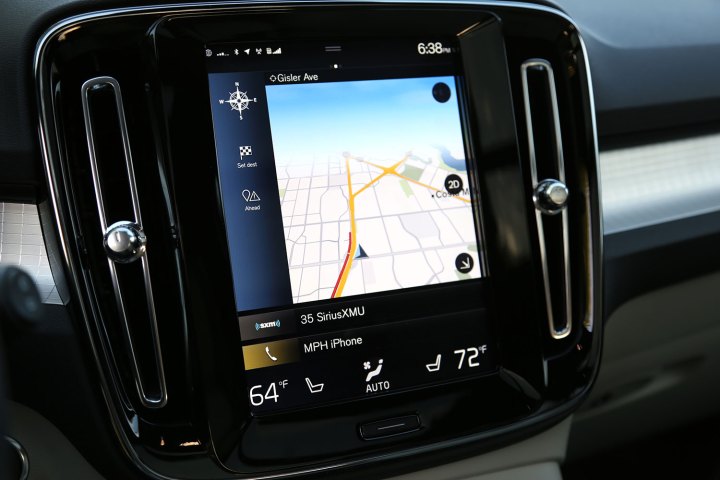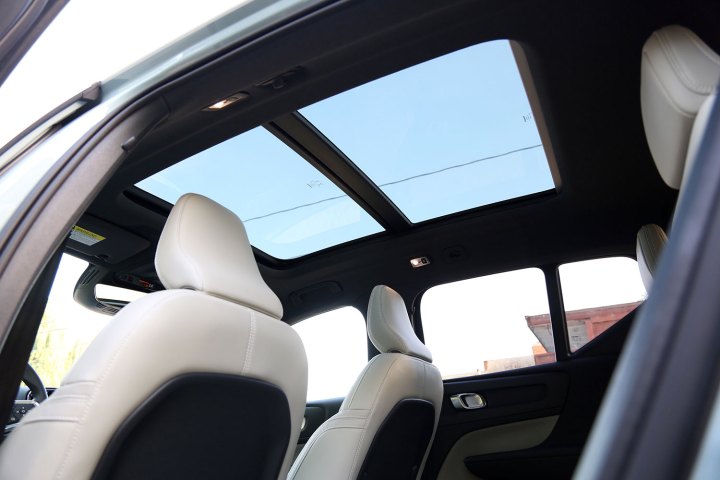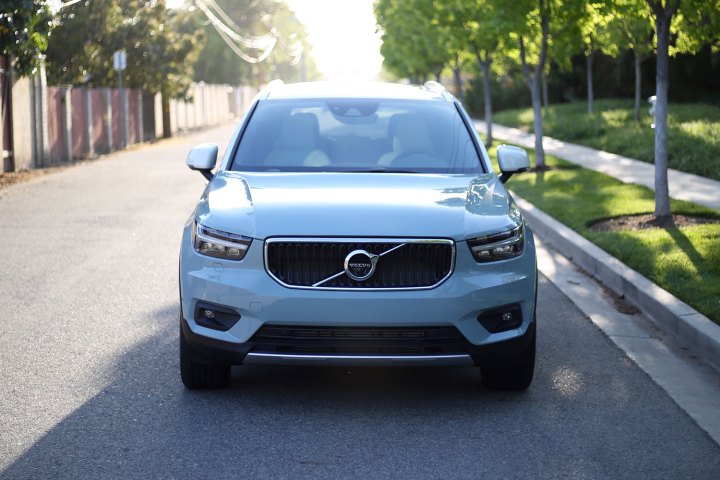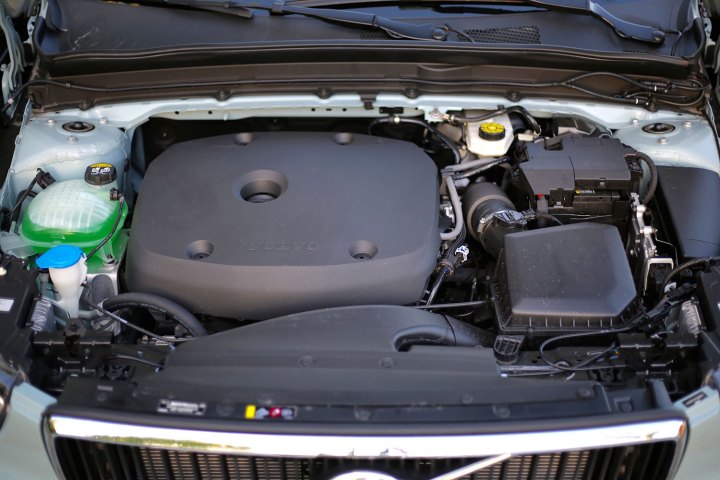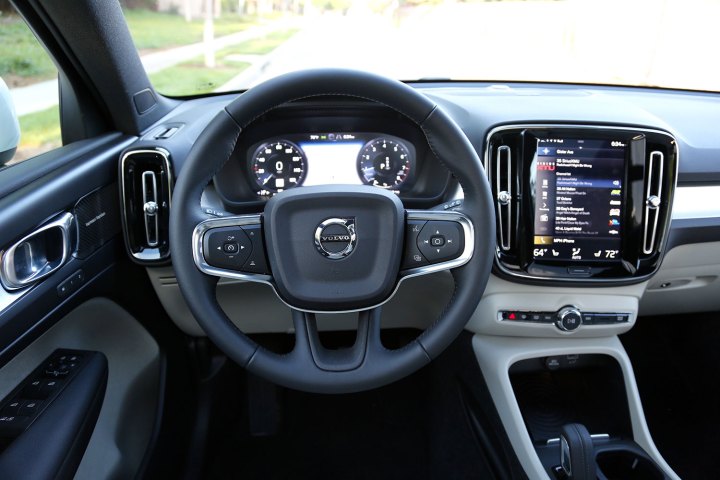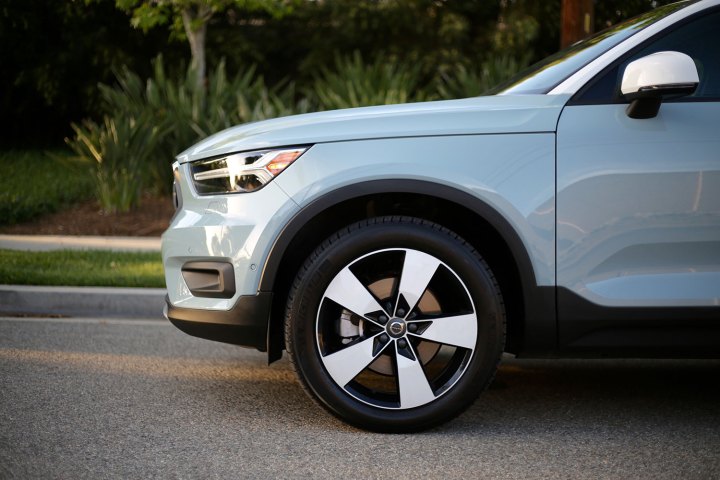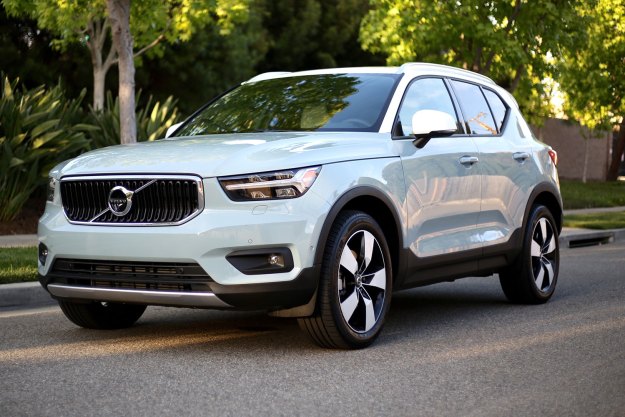
“The XC40 doesn’t just hold its own, it rises above the rest.”
- Fresh, upscale styling
- Supremely comfortable seats
- Spunky powertrain
- Smart interior storage
- Hard to achieve MPG estimates
- Infotainment can be finicky
Volvo has made good cars for a long time, yet few luxury shoppers remember to include the Swedish automaker when discussing viable modes of transportation. The reason, as far as we can tell, is because Volvo has always been a little … dull. Safe? Absolutely. Comfortable? You bet. High Quality? Totally. These attributes may have sold cars 20 years ago, but today, luxury vehicles need to dazzle with technology and style, too.
About three years ago, Volvo started to get the picture. The second-generation XC90 SUV brought with it a completely new design language and innovative convenience features that encouraged folks to look at the brand in a new light. That was just the beginning, though. An all-new S90 sedan, V90 wagon, XC60 SUV, V60 wagon, and XC40 compact crossover have since emerged to spread the message of a reborn Volvo.
While each of these vehicles shakes up its respective arena, the XC40 has the best chance of knocking BMW, Audi, and Lexus down a peg or two. Volvo’s smallest SUV is the company’s most youth-oriented offering, serving its target audience a healthy dose of contemporary chic. BMW’s X1 ($33,900), Audi’s Q3 ($32,900), and Lexus’ NX ($35,985) entered the compact luxury SUV segment first, but Volvo’s XC40 may be the fashionably late favorite. Our test of the T5 AWD Momentum ($35,200) puts the brand’s best features on display.
The Volvo XC40 sets the right tone out of the gate with a fresh, unique look that is both on-brand and upscale.
The Volvo XC40 sets the right tone out of the gate with a fresh, unique look that is both on-brand and upscale. From some angles, the XC40 is conservatively handsome: Volvo’s corporate grille and T-shape headlights match a spelled-out Volvo badge on the handle-less trunklid. From other views, though, the XC40 steps out of its segment shell. An available contrasting white or black roof that extends partway down the notched C-pillar is one of our favorite cues.
Though familiar, the XC40’s signature LED taillights give the rear plenty of appeal. A flat, clamshell hood affords the front a sleek look and the side an upright stance. Available five-spoke 19-inch wheel designs (added to our tester) sit nicely within their body clad wheel housings. In short, the XC40 walks the line between refined and riveting, perfectly.
Interior and tech
Exterior styling is largely subjective, but one can really break out the scales to measure interior quality. The XC40 combines unique materials with class-leading convenience technology and traditional comfort for a winning cabin experience.
We love to see outside-the-box thinking when it comes to compact vehicles, so Volvo’s creative storage solutions, including a cubby beneath the driver’s seat, a built-in waste receptacle, and a reconfigurable trunk floor are standout wins. Other clever features include automatic folding rear headrests that create better rearward visibility and make folding the 60/40 split rear bench a breeze, a power lift gate with hands-free opening, and keyless entry/exit for all four doors.
Cabin comfort and passenger space is among the best in this segment. We particularly appreciate the XC40’s front seats, which are supremely soft and supportive. Rear passengers benefit from ample legroom and headroom, with plenty of light coming through the available panoramic sunroof. The XC40’s trunk accommodates 21 cubic feet of storage, and can expand to 47.2 cu. ft. with the rear seats folded. BMW’s X1 fits more behind its second row, but Lexus’ NX and Audi’s Q3 are at a spatial deficit.
The XC40 combines unique materials, class-leading convenience tech, and traditional SUV comfort for a winning cabin experience.
Fit and finish is right on par with BMW’s X1 and a step up from Audi’s Q3 and Lexus’ NX. The use of duo-tone carpeting, a contrasting headliner, and tiled dashboard trim with a pearlescent finish perks up an already premium layout. Every T5 AWD model ships with a 9.0-inch center touchscreen display (with Apple CarPlay and Android Auto) and a 12.3-inch digital driver display that put the XC40 on the cutting edge of its segment. While competitors offer similar technologies, only Volvo equips these as standard.
Also included is a Wi-Fi hotspot, three USB ports (two front, one rear), a 250-watt sound system, Bluetooth, Sirius XM radio, and Volvo’s On Call app with controls for remote start, door locks, and more. For additional techno-dazzle, Volvo offers Sensus Navigation, a 600-watt Harmon Kardon sound system, wireless phone charging, and a 360-degree surround view camera.
Unlike rivals who tack their displays onto the dashboard like an afterthought, Volvo’s infotainment is integrated beautifully. Utilizing the tablet-like display is simple, with swipe, pinch and zoom functions to take you through driver aid settings, media, navigation, and all other vehicle apps.
The infotainment isn’t perfect, though. More than once, the screen hesitated a full second after we gave it a directive, and the backup camera didn’t seem to want to leap into action immediately after startup.

This being a Volvo, safety is a priority. In addition to passive safety features like a full suite of airbags and LED headlights/daytime running lights, the XC40 comes standard with several active driver aids, including automatic emergency braking, road sign information, lane keeping assistance, oncoming lane mitigation, and pedestrian detection.
Available driver assistance features include adaptive cruise control, blind spot monitoring, rear cross-traffic alert and braking, and parking assistance. Only the Lexus NX offers a similarly comprehensive suite of safety technologies as standard, with the BMW X1 and Audi Q3 offering many active aids for additional fees.
Driving experience
Under the Volvo XC40’s clamshell hood is a 2.0-liter turbocharged four-cylinder producing 248 horsepower and 258 pound-feet of torque. All-wheel drive is standard, as is an eight-speed automatic gearbox. Output for the XC40 exceeds all its key competitors, including the 228-hp BMW X1, and its 0 to 60 mph sprint of 6.3 seconds is quickest of the bunch. Later this year, Volvo will introduce a more affordable T4 model with 187 hp.
Unlike performance-oriented vehicles, driving the XC40 is downright therapeutic..
The XC40 comes standard with a few drive modes, including Eco, Comfort, Off-Road, Dynamic, and Individual (a customizable setting for steering and powertrain response). Though the differences between these modes are subtle, and the XC40’s suspension damping remains unchanged, Off-Road and Eco mode are useful for their intended driving conditions.
In its default Comfort mode, the XC40 builds momentum smoothly, working through the gears to find a balance of efficiency and power. Despite the XC40’s upright stance, there’s little wind noise at highway speeds.
In corners, the chassis is composed and nimble, but this SUV is best experienced at a modest pace – that’s when you can really appreciate its supple ride quality. Indeed, unlike performance-oriented vehicles, driving the XC40 is downright therapeutic.
The EPA rates Volvo’s smallest SUV at 23 city, 31 highway, and 26 combined mpg, but during our week of testing (primarily in Comfort mode with engine start/stop turned on), we averaged just 22 mpg. It might require operating in Eco mode to hit the EPA’s estimates, but it’s hard to imagine everyone driving that way 24/7. By comparison, BMW’s X1 xDrive (AWD) averages an equal 26-combined mpg, Audi’s Q3 AWD achieves a segment-low 23-combined mpg, and Lexus’ NX 300 AWD comes in at 24-combined mpg.
Warranty
Volvo offers a four-year, 50,000-mile new car warranty, plus an available two-year extended warranty. Included in the standard package is three years (or 36,000 miles) of free scheduled maintenance. Volvo’s reputation for reliability is somewhat convoluted. Consumer Reports ranks Volvo 23 out of 27 major manufacturers for the 2018 model year J.D. Power ranks Volvo a bit higher, placing its cars about average in overall dependability.
Online discussions show many customers experiencing difficulties with their infotainment and other new convenience features. Mechanically, however, Volvo is often praised for reliability. The takeaway seems to be that owners may experience some software issues within the warranty period, but probably won’t need AAA Roadside Assistance on speed dial.
How DT would configure this car
Our perfect Volvo XC40 looks much like our test vehicle, with a few small tweaks. To start, we’d choose the T5 AWD Momentum with a Fusion Red Metallic ($595) exterior, Ice White contrasting roof ($300), and Amber leather interior. We really dig those 19-inch five-spoke wheels ($800), so add those into the mix.
On the package front, we’d equip the Premium Package ($1,400) with adaptive cruise control, dual-zone climate control, keyless entry, power front passenger seat, and power folding rear seats. Next, we’d choose the Multimedia Package ($1,375) with navigation and a 13-speaker Harmon Kardon sound system. Also appealing is the Vision Package ($1,100), which includes parking assist with front and rear sensors, blind spot monitoring, cross traffic alerts, power folding side mirrors, and auto dimming interior and exterior mirrors. One final option to open up the cabin would be the panoramic sunroof ($1,200). The final score would be $42,875, including destination and handling.
Our Take
There isn’t an ideal spot to mention Care by Volvo in the thick of this review, but it’s worth addressing here. Volvo is among a small group of automakers that are pioneering subscription models for their vehicles.
As an alternative to leasing or buying the XC40, Volvo allows customers to “subscribe” to the SUV for a monthly fee paid over a two-year contract. For $600 each month, customers get a T5 AWD Momentum trim XC40 with the Premium package, the Vision package, heated front seats, a heated steering wheel, a panoramic roof, and 19-inch alloy wheels.
As part of the agreement, Liberty Mutual automotive insurance, a concierge service, roadside assistance, and maintenance are included. While deal hunting on independent insurance and a lease offer could theoretically undercut Volvo’s monthly fee, avoiding the hassle of dealer negotiations may be worth a small premium.
Whether through the subscription model or traditional car buying methods, the Volvo XC40 is absolutely worth checking out. Among its competitors, the XC40 offers the best roster of standard features and the most intriguing combination of exterior and interior styling. For optimal driving dynamics, BMW’s X1 ($33,900) holds the lead, and for the cushiest ride, Lexus’ NX ($35,985) is the comfort king, but Volvo’s XC40 packs a little of everything that makes a luxury compact SUV great.
Should you get one?
Volvo’s fresh styling, legendary safety, and cabin comforts have finally trickled down to an affordable SUV. The XC40 more than holds its own in a competitive segment; it rises above the rest.
Editors' Recommendations
- 2021 Volvo XC40 Recharge first drive review: Refined EV subtlety
- Audi Q3 Sportback crossover is a mini Q8 that won’t come to the U.S.
